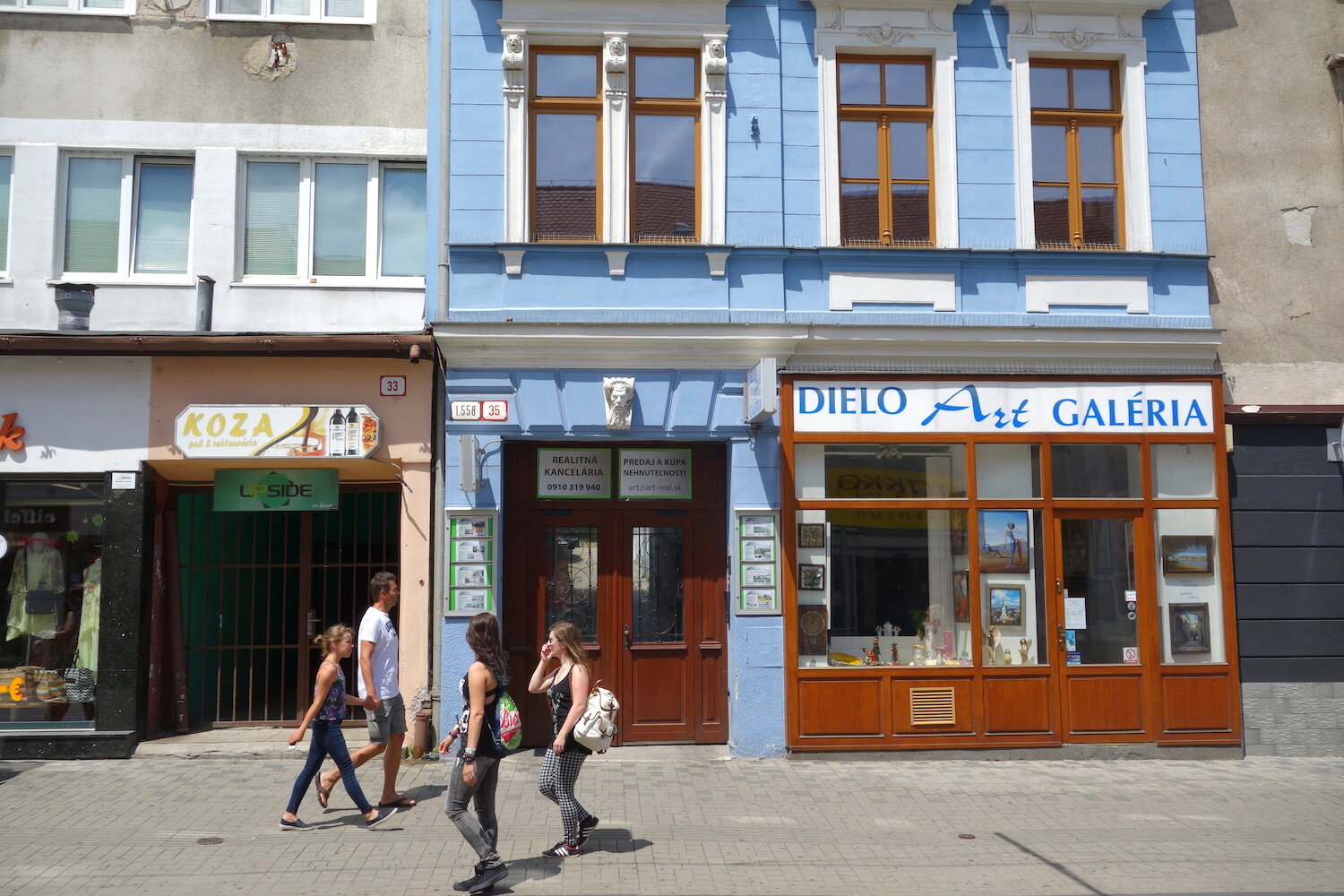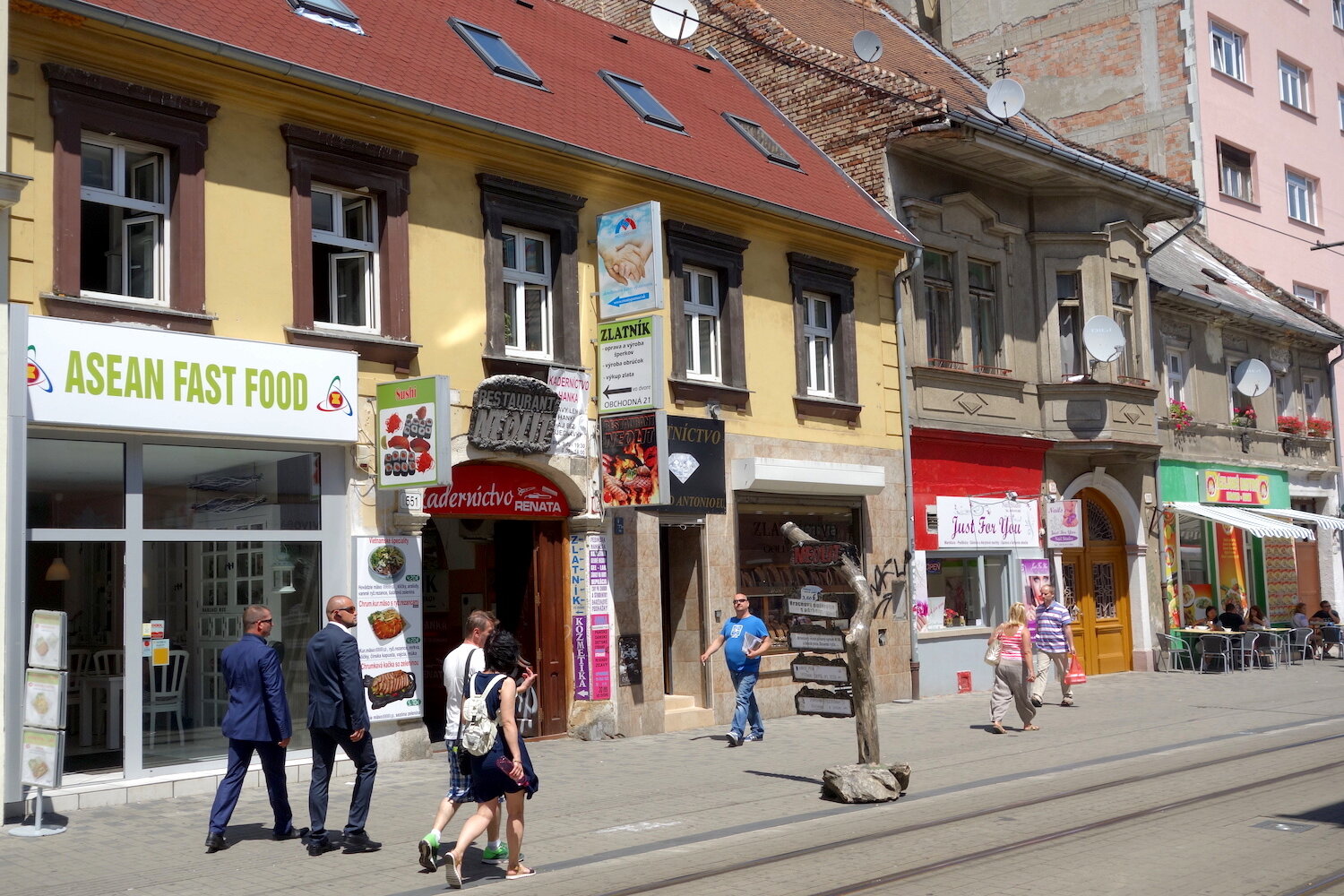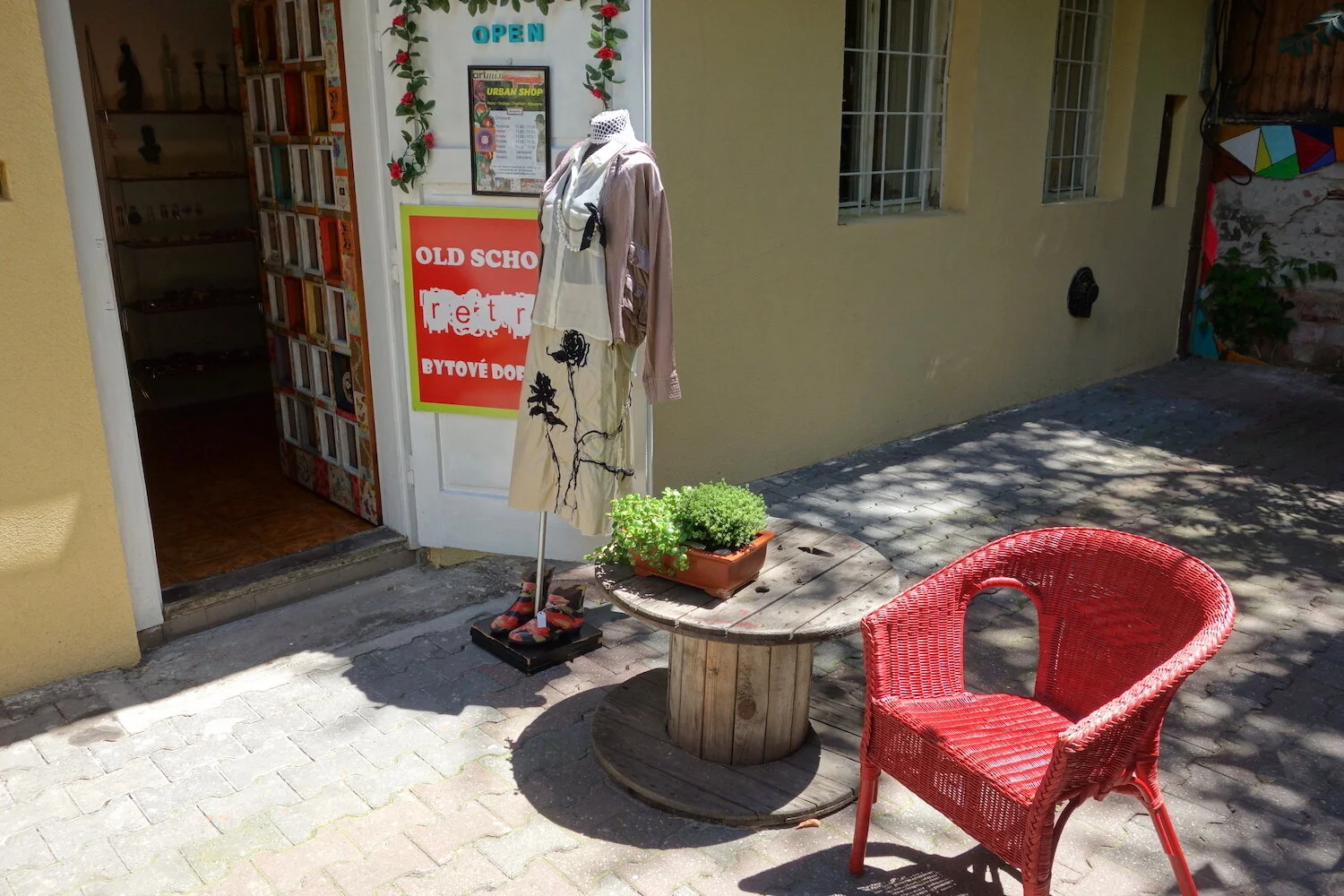A Street in Bratislava: Searching for a Post-Communist Urbanity
If you visit Bratislava, you will most likely explore the Staré Mestro, or Old Town (figure 1). Lining the north bank of the Danube, the city's historic center features a capacious central square, a grand red-roofed town hall, and a collection of lofty churches, palaces, and gates. The beautiful medieval and Renaissance architecture, coupled with the surprisingly intact urban fabric, has drawn tourists to Bratislava for decades since the fall of communism.
What you might miss, unless you leave the tourist circuit, is Obchodná (figure 2). Located just to the east of the Old Town, Obchodná is one of Bratislava's main commercial streets. Along with the surrounding lanes, passages, parks, and squares, Obchodná channels the everyday life of ordinary Slovaks as they go about their business. Some 40,000 pedestrians pass through each day, shopping, running errands, meeting friends, or just going for a stroll. It is here, tucked away behind the Old Town, that residents negotiate their place in a post-communist society--a society both wary of and drawn to the global reach of Europe.
“Since the partition of Czechoslovakia in 1993, Bratislava has searched for its footing as an independent capital with its own kind of post-communist urbanity ”
Bratislava is one of Europe's smallest capital cities, with a quiet and understated beauty. Alternately known as Pressburg and Pozsony by its erstwhile Hapsburg and Hungarian rulers, Bratislavans lived for decades in the shadow of foreign capitals. Proximity to mighty Vienna, a mere 50 kilometers to the west along the Danube, shaped this tiny outpost in ways that can hardly be underestimated. Slovaks themselves were long in the minority among the city's inhabitants: in 1880, only 17 percent of the population was Slovak, while 19 percent were ethnic Hungarians and 64 percent ethnic German. Two world wars, decades of Communist rule, and secession from the domination of Prague have dramatically altered the balance. Today, Slovaks comprise fully 92 percent of the city's population.[i]
Since the partition of Czechoslovakia in 1993, Bratislava has searched for its footing as an independent capital with its own kind of post-communist urbanity. While evidence of German, Hungarian, and Soviet rule abounds in the architecture, Bratislava is an undisputedly Slovak city. Once a crucial outpost of imperial power and crossroads of warring armies, the city today moves under a quieter register, satisfied to trade faded glories of a martial past for the freedom and independence that residents enjoy today. A small but energetic art scene has even taken hold, and several galleries have popped up on Obchodná, including Dielo (figure 3), and the excellent Center for Folk Art Production down the street.
Despite this newfound prosperity, immigrants have arrived slowly since the dissolution of the Communist regime, mostly from Czech Republic, Croatia, and Ukraine. Nationalist elements have gained ground over the past decade, particularly in opposition to Muslim migration and refugee settlement, creating a tense and hostile environment for foreign workers and their families. Even the relatively moderate Social Democrat Prime Minister Robert Fico proclaimed that the Republic would only accept Christian migrants, and that his government would conduct surveillance on all Muslim residents. He further stated that he would only take migrants if the European Union accepted some of the 500,000 Roma currently living in the Slovak Republic.
“Bratislavans tack continually between the contentment of a fully Slovak city, and the alarming prospect of being left behind amid the transformation of other European capitals into global, multiethnic centers of urban life.”
Those immigrant families that do call Bratislava home keep a low profile, wary of provoking nationalist ire. On World Refugee Day in 2015, 5000 neo-Nazis and other right-wing extremists marched through Bratislava in a permitted demonstration, chanting slogans against Muslims, Jews, Roma, the EU, and "traitor Slovaks." Given such levels of state-sanctioned terror, few migrants or refugees even bother to seek asylum in the Slovak Republic. According to the UN's Organization for Economic Co-operation and Development, of the 10 million people forced to leave their home countries in 2016, only 146 applied for asylum in the Slovak Republic.[ii]
Nevertheless, Bratislavans yearn for the recognition of their city, and for inclusion among the capitals of Europe. After all, looking just beyond Europe, they see Turkey, the Middle East, and North Africa—company they do not wish to keep. They want to be part of Europe, but view the institutions of European governance as compromised and corrupt. As a consequence, Bratislavans tack continually between the contentment of a fully Slovak city, and the alarming prospect of being left behind amid the transformation of other European capitals into global, multiethnic centers of urban life.
Enter Obchodná, historically known as Schöndorfská ulica, it served for centuries as a market road, cutting through the Schöndorfského suburbs to Michalská Veža (Michael's Gate) at the city's medieval wall (figure 5). The area was home to numerous vineyards, with wine wholesalers and taverns lining Schöndorfská street (figure 6). Since the mid-nineteenth century, the thoroughfare has been incorporated into Bratislava proper, beginning its life as an extension of Michalská Street and travelling just under a kilometer until terminating at Kollárovo Square. As the district built up rapidly after World War I, the municipal government renamed the street Obchodná, which roughly translates as "commerce."
A variety of businesses line Obchodná, from pubs to cafés, bakeries, banks, drugstores, electronics kiosks, appliance shops, and jewelers. Kebab joints are a common feature of everyday life, although there are very few Turkish people in the Slovak Republic (figure 7). And while the country hosts a population of some 3,000 migrants from Vietnam, there are no Vietnamese restaurants or businesses on Obchodná. Meanwhile, a few national and global chains have snuck in, including H&M, Century 21, and McDonald's, but they constitute a small presence, at least for the time being.
“Today, in place of the traditional study of German or Russian, students pursue English lessons in one of several language studios on Obchodná. ”
A restored tram runs the length of the Obchodná, which was repaved and pedestrianized in the early 2000s (figure 8). Tram line 1 connects the Technical University with the Univerzita Komenského, located in the old town near the Danube, ensuring a steady stream of students from both directions into Obchodná. Without the presence of the universities, in fact, the city's population would be highly skewed toward the elderly. Today, in place of the traditional study of German or Russian, students pursue English lessons in one of several language studios on Obchodná. Signs for English tutoring appear up and down the street on poles, bulletin boards, doors, windows, and fences.
Meanwhile, several passages break off from the street, some arcaded and others open to the air. Most famous is Royko Passage, lined with shops selling jewelry, luggage, clothes, and other goods (figure 9). Designed by Slovak Jewish architect Ernst Steiner in 1932, the weighty, stripped-down version of the Art Deco style proved popular for new housing complexes and commercial buildings erected in the 1920s and 1930s across Central Europe. [iii] The building and passage went into decline in the 1970s and 1980s, but were restored in 1999 by two local firms. The original sign had been lost, and a new version was fabricated based on archival documents and photographs.
Passing through an old carriage court door on Obchodná, one enters "Dvor 66," another arcade lined with small cafés, galleries, and specialty shops. Here, shops such as Lavender serve a dedicated LGBT clientele, selling soaps, linens, dried flowers, and gourmet teas and coffees (figure 10). Further down to the right is Bystra, a language school specializing in English classes, and Veggie, a vegetarian restaurant. The lower cost of shops in these passageways allows for a wide variety of innovations, and marks a contrast with the high-volume and luxury retail establishments along Obchodná proper.
“[Obchodná] presents a roughly textured and unfinished urban landscape that attracts creative residents eager to try new ideas in retail, commerce, and culture making. ”
In these twisting backstreets, cheap rents allow for niche businesses such as small boutiques, vegan restaurants, artist studios, used furniture stores, and vintage clothing shops. Here the smell of patchouli mingles with pot smoke. Many of these spaces had become abandoned and derelict under late communist rule, and black-market trading proliferated in the hidden folds off Obchodná. Beginning in the 1980s, with economic reforms, and gaining steam after the Velvet Revolution, small retail enterprises multiplied along the street. Most of them are run by young Bratislavans and cater to the student and counter-cultural crowd. Old School Retro, shown in figure11, features a lively mix of 1950s-1960s furniture, kitchenware, radios, linens, bric-a-brac, and books--a veritable exhibition of Communist-era Eastern European material culture.
Bratislavans who want to enter into retail trade, but cannot afford to rent a shop in the area, will start off selling in one of the city's flea markets. One such market is Jedlikova Passage, just off of Obchodná. It is open year-round, protected from rain and snow by a complex ensemble of tarpaulins, awnings, and corrugated metal panels. Shoppers can enter from Obchodná (point A in figure 12) and pass through a warren of tables and small kiosks, exiting at the "back" onto Kolárska street (point B in figure 12). Vendors in the passage sell clothes, household goods, sunglasses, toys, garden sculptures, fabrics, and other items. Most of the merchandise comes from China and Malaysia, with prices that easily undercut European-made goods (figure 13). The vendors themselves are primarily Slovak and Romany men, serving a clientele of lower-income Bratislavans looking to save money.
If you walk the length of Obchodná, you will arrive at Kollárovo Námestie (Kollárovo Square), where Obchodná terminates, splitting into two streets (figure 14). One block further along sits the massive Soviet-era architectural ensemble known as Námestie Slobody, which rose up to replace the grand lawn once attached to the summer palace of the Archbishops of Esztergom. After the 1948 revolution, the square was renamed in honor of Czechoslovakia's first Communist president, Klement Gottwald, and today is still known locally as "Gottko" square. The Ministry of Transport, Construction and Regional Development looms in the background, with the inoperable Fontána Družby, or "Fountain of Unity" at left (figure 15). The relative dereliction of this complex contrasts with the highly preserved state of the Old Town, creating a stark juxtaposition between versions of Bratislava's history and identity made available to tourists.[iv]
“The post-communist dream of a society made free through the resolving power of the market has created winners and losers.”
Between these two versions of history sits Obchodná, quietly experimenting with the city's future. With none the grandeur of the Champs-Elysées or Ringstraße, or the commercial élan of The Strand or Nevsky Prospekt, Obchodná nevertheless punches above its weight. It presents a roughly textured and unfinished urban landscape that attracts creative residents eager to try new ideas in retail, commerce, and culture making. The multiple bright signs and small businesses occupying the otherwise rumpled old buildings reveal an understated but energetic optimism. While there is little to draw tourists (not necessarily a bad thing), it remains a popular regional shopping district for Slovaks.
And yet, these days Obchodná vibrates with a quiet melancholy, even perhaps a sense of resignation (figure 16). The post-communist dream of a society made free through the resolving power of the market has created winners and losers, a class-stratified society reflected in commercial streets like Obchodná, with its high-end boutiques and galleries juxtaposed against struggling shops and rickety flea markets. Moreover, despite the 'work-in-progress' energy found on Obchodná, its glory days as a busy, cosmopolitan city at the crossroads of great empires are long gone. As figure 16 shows, residents are keenly aware that Bratislava is not Paris.
At the same time, Bratislavans have largely rejected the heterogeneity that makes Paris one of the world's great cities. The commitment among residents to maintain their Slovak identity at all costs puts them at odds with European trends toward ethnic pluralism and a nominally cosmopolitan social order. Bratislavans crave the consumer goods of global capitalism, but reject the diversity of people that comes with global mobility. They yearn for the respect of their counterparts in Vienna and Berlin, but enact harsh policies against immigration that contravene European Union principles.
Whether Slovaks will relax their views and open their borders to a freer flow of people remains to be seen. In the meantime, Obchodná is a good place to catch a glimpse of a post-communist Eastern European city struggling to find its identity in an increasingly global age.
Notes
[i] Pieter C. van Duin, Central European Crossroads: Social Democracy and National Revolution in Bratislava (Pressburg), 1867-1921 (Oxford, UK: Berghahn Books, 2009); Stanislav Kirschbaum, A History of Slovakia: The Struggle for Survival (New York: St. Martin's Griffin Press, 2005).
[ii] Roman Cuprik, "Asylum seekers avoid Slovakia," The Slovak Spectator, 11 July 2017. Also consult the entry for Slovakia in the Global Detention Project.
[iii] Robert Neurath, “Bratislava Pressburg Pozsony: Jewish Secular Endeavors, 1867-1938,” (unpublished manuscript).
[iv] Marián Potočár, "A Monument and a Blindspot – On the Precarious State of Modernist Architecture in Bratislava," Field Journal 6, no. 1 (2017).





















